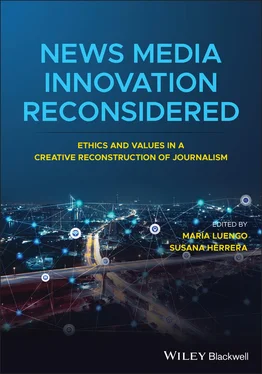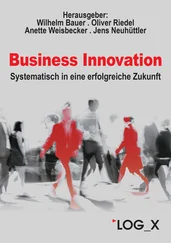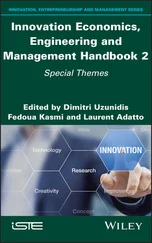Just as technology and economics bring the “destructive” element, they also embody the “creative” one. Responses to the transformations of journalism include technological innovations, innovative ways to measure and analyze audience figures, and new business models (sources of revenues, ownership, and financial sustainability). The success or failure of new media are also measured and assessed according to techno-economic factors. Through the process of creative destruction, technology and economics impose “a regime of trial and error and of making wagers,” as Jean-Gustave Padioleau puts it. The image of creative destruction establishes a present scenario and foresees a digital future in which new players are forced to compete with old ones, and new arrivals successfully win niche markets using up-to-the-minute technology. Padioleau observes that “under the guise of innovation, activities disappear to make room for newer, more ‘creative,’ more reliable/efficient ones. According to Schumpeter, creative destruction is at the heart of economic growth” (Padioleau, 2006, p. 110).
Schumpeter’s economic reductionism parallels a narrow technological understanding of journalism innovation. Drawing on research on journalism in Canada, Hermida and Young’s thought-provoking Chapter 3in this book examines whether legacy newsrooms’ defensive adoption of innovation “as a technological-led solution” to economically navigate financial turbulence has been to their detriment. By entering into “the cycle of the never-ending pivots in the search for the killer innovation that will save the media,” Hermida and Young say, journalistic organizations get trapped in it. And in times of survival, they argue, few can afford to adopt the latest shiny new technology.
Seeing Creative Destruction as Creative Reconstruction
Padioleau (2006, p. 10) is critical of the use of the term “creative destruction” in describing the crisis facing the media, on the basis that it is misleading. Is creative destruction a deceptive label? This terminology focuses mainly on economics and ignores the critical cultural and ethical component when explaining current changes in journalism. This book aims to put current technological innovations of journalism into the broader context of professional ethics and civil values. It examines journalism innovation from the energizing of ethics, looking at specific arenas of such innovation, from new forms and narratives to processes and ways of dissemination.
Without denying the tangible role played by digital technology and market conditions in reshaping the news today, this collaborative book takes a different angle to interpret recent changes in news media. Contrary to reductive techno-economic explanations, the contributors’ analyses of new journalistic forms and practices help show the power of journalistic and civil values for invigorating the profession. By looking at the ethical dimension of different initiatives and innovations in various countries, the chapters in this book seek to advance cultural and ethical insights into journalistic innovation.
Alexander (2016, p. 2) points out that:
Recent technological change and the economic upheaval it has produced are coded by social meanings … Cultural codes not only trigger sharp anxiety about technological and economic changes; they also provide pathways to control them, so that the democratic practices of independent journalism, rather than being destroyed, can be sustained in new forms.
Following Alexander, contributors to this book were invited to look at news media innovations from the ethical values that make technological innovation sustainable. The various contributions to this book make it possible to identify the ethical and professional codes that are invigorating the profession through digital technologies. The selected innovations are characterized by an online-only or online-first approach, conveying the news via websites, mobile apps, or social networks. They integrate experienced journalists, journalistic entrepreneurs, reporters, and computer scientists.
The ethical perspective deployed to cross-examine the different innovations discussed also serves as the basis for the theoretical argument behind this book: ethics and values can be envisioned as pathways to a creative reconstruction of journalism. This new conceptualization transcends the economic logic of a creative destruction, which, according to Alexander (2016), would result in the destruction of the economic foundations of journalism. “Journalism would become Exhibit A of capitalist ‘creative destruction,’” he observes [p. 7]. In this vein, in the following two sections, I wish to briefly draw attention to the performative power of journalism for innovative repair by looking at the professional and civil values that may be generating and sustaining new entrants in the news media digital ecosystem. To what extent does the ethics of journalism prevail and foster quality journalism through innovation within new disruptive digital scenarios? How are these ethical values shaped by new journalistic initiatives? To address these questions, I first use some of the closing remarks of Breese and Luengo’s (2016) “News Innovations and Enduring Commitments” chapter as scaffolding to semiotically map the arena of news media innovation as a symbolic place where journalism’s entrenched ethical codes are being re-signified. Then, I apply this theoretical framework performatively to new journalistic forms and practices at the intersection between ethics and technological innovation. This last section will serve as a more explicit introduction to the specific content of the chapters.
Mapping News Innovation Culturally
A cultural sociology insight into news media innovation allows us to reconsider how the core journalistic values of long-established new media organizations are now being re-signified by new technologies, work processes, and forms of news production and distribution. While the meanings of technologies and practices quickly change, the symbolic codes of journalism remain. Professional values such as “truth,” “accuracy,” “independence,” and “criticism” represent some of the cultural codes of professional journalism, while “falsehood,” “bias,” “inaccuracy,” and “dependence” often describe counter-values of professionalism (Breese and Luengo, 2016). When journalism entered the digital era, the printing press and legacy media had a monopoly over codes of professional journalism, whereas the Internet and new digital media have stood for opposing values. García-Avilés’s Chapter 1reflects the way in which these values and counter-values of professionalism explain the initial uneasy relationship between ethics and digital technologies in journalism. From 2008, enduring journalistic values have been incorporated into a narrative of “crisis” (see Hermida and Young’s Chapter 3) shared by many practitioners, experts, and scholars (Alexander, Breese, and Luengo, 2016). The crisis narrative associated technologies, forms, and practices of traditional media, particularly printed newspapers, with professional journalism. Many forms, practices, and processes of well-established news organizations around the world had already become potent symbols of professionalism. Traditional media were “signifieds” (meanings) of a broader “signifier” — professional journalism. As Figure I.1 shows, there is an ongoing relationship between signified and signifier. What was signified becomes possible signifier. By combining signifier and signified, many traditional forms of journalism became signs (symbols) of core journalistic and democratic values. Based on this signification, digital technologies have been coded as tangible sites of the threat to the profession.
Читать дальше












